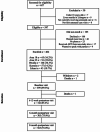Clinic transfers and engagement in HIV care during the perinatal period across a network of healthcare centers in Lilongwe, Malawi
- PMID: 39367352
- PMCID: PMC11451223
- DOI: 10.1186/s12884-024-06865-6
Clinic transfers and engagement in HIV care during the perinatal period across a network of healthcare centers in Lilongwe, Malawi
Abstract
Introduction: Disengagement from HIV care during the perinatal period remains a challenge. Improving engagement in HIV care requires monitoring engagement across multiple indicators, including retention in HIV care, visit adherence, clinic transfers, and viral suppression to support improved clinical and programmatic outcomes.
Methods: We enrolled a prospective cohort of pregnant WHIV across a network of five urban clinics in Lilongwe, Malawi from February 2020-February 2021. WHIV were followed from their first antenatal care visit through 9 months postpartum across all study sites using biometric fingerprint scanning. Study visits occurred at enrollment into antenatal care, 6 weeks', 6 months, and 9 months postpartum. In addition, all usual care HIV visits were captured via medical records. Participants who missed a study visit or usual care visit were traced. We evaluated determinants of multiple indicators of engagement in care, including retention in HIV care (attending a scheduled visit or self-reported recent visit when traced), HIV visit adherence (missed scheduled HIV visits and HIV visit coverage), clinic transfers, and viral load suppression (< 1000 copies/mL) using modified Poisson regression and sub-distributional hazard ratios to account for competing events of death and loss-to-follow-up. Associations between clinic transfer and subsequent indicators of engagement in HIV care were evaluated using generalized estimating equations.
Results: Among 399 participants, 81% were on ART at baseline. Retention in HIV care was 87% at 6 weeks postpartum, 77% at 6 months postpartum and 89% at 9 months postpartum. At 9 months postpartum, 91% of participants were virally suppressed, 81% had missed a scheduled HIV visit, and 19% had transferred clinics. WHIV who transferred clinics were most likely to miss their subsequent scheduled HIV visit by ≥ 30 days. Transferring clinics was not associated with unsuppressed viral load or non-retention at 9 months postpartum.
Conclusions: In a cohort of WHIV, retention and viral load suppression were high in the perinatal period, but missed HIV visits and clinic transfers were common. Transferring clinics was associated with an increased likelihood of missing a subsequent HIV visit. Clinic transfers may be important indicators of disruptions in clinical care for WHIV in the perinatal period.
Keywords: Engagement in HIV care; HIV care continuum; Malawi, Retention in HIV care; Option B+; Viral load suppression.
© 2024. The Author(s).
Conflict of interest statement
The authors declare no competing interests.
References
-
- WHO. Consolidated guidelines on the use of antiretroviral drugs for treating and preventing HIV infection: recommendations for a public health approach. Geneva, Switzerland: World Health Organization; 2013. - PubMed
-
- UNAIDS. Prevaling against pandemics by putting people at the centre - world AIDS Day report 2020. Geneva: UNAIDS; 2020. 26 November 2020.
-
- Lyatuu GW, Mwashemele SZ, Urrio R, Naburi H, Kashmir N, Machumi L, et al. Long-term virological outcomes in women who started option B + care during pregnancy for prevention of mother-to-child transmission of HIV in Dar Es Salaam, Tanzania: a cohort study. Lancet HIV. 2021;8(5):e256–65. - PubMed
MeSH terms
Grants and funding
LinkOut - more resources
Full Text Sources
Medical


